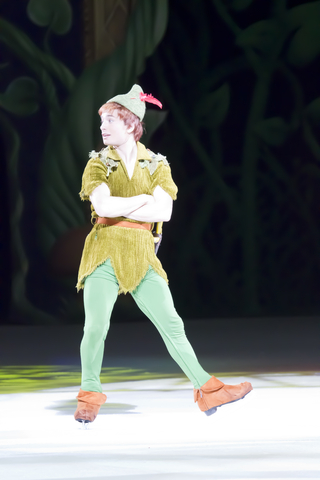Peter/Wendy was an instant success.
Done in collaboration with the BA Theatre Studies Class of 2013, the show featured a small cast of senior theatre studies majors from Montclair State University. It was a small cast, but a memorable one, each stealing the stage in their own unique way.
Maureen Elford, cast as gender-blind Peter Pan, really brought something special to the character. Her portrayal was as realistic as would have been done by a more age-appropriate young boy.

Also notable for his performance was Michael Joel, cast as Hook. He easily captured the audience’s attention and brought a duel dimensionality to the character that made him too easy to sympathize with for a villain, especially when it came time for his end. The whole cast was comprised of only nine characters, all of which played ensemble in the bigger pieces of the show, in addition to acting as leads. However, despite their limited number, they definitely made an impact with their “Peter/Wendy” performance.
The costuming of these characters was simple and limited, but that did not take away from the “Peter/Wendy” performance. They were dressed in their pajamas and, in Hook’s case, accompanied by a dressing gown. Tinkerbell, alternatively, was dressed in all black, except for her LED-tipped gloves. This added to the phantasmagoric feel of the show, a story that takes place at night after goodnights have been said and children have been tucked in. It allowed for the ensemble pieces to look concise and together, while still keeping in character and following within reason from the show.
The “Peter/Wendy” set was visually simple, composed mostly of the raked stage, angled both for improved view for the audience as well as the simulation of flight on stage. This show was very movement-heavy: not a dance piece, but still visually rooted in the dynamics of the movement on stage, something especially true in the ensemble pieces. Within the stage there were a number of trap doors that were used at various points within the show, both as entrances and exits for comedic purposes or to separate action from on the deck of Hook’s ship and below deck.
These doors were also used to help simulate flight. Characters, namely Peter and Wendy, who were trying to fly would step onto the doors, only to be pushed up into the air, elevated by the feet of the actors who were below stage. This was a very low-tech but comedic and effective way to get the point across during the show.
There were very few “Peter/Wendy” props, only a twin bed that was moved on and off stage during several scenes and a variety of lamps that were used by the actors, mostly in the ensemble pieces in order to accentuate their movement.
The lighting design was gorgeous. Opening in a blue special, the stage glowed beautifully, recreating the dark of night. There were spot lights, side lights, lamps used by the actors, light bulbs lowered from above by the stage hands and the unique glowing of Tinkerbell’s fingertips.
The most stunning and heart-warming element of the set design, however, must have been the chalk design. The entire “Peter/Wendy” stage was covered in chalk. Had you arrived early, the audience was able to watch the actors dancing around the stage, writing all over both the wall and floor in brightly colored chalk whatever they wanted, their “happy thoughts.” It is said in the story that you need to think happy thoughts in order to fly, and the cast definitely had enough written out to get them soaring high into the sky, a variety of things written including the names of friends and family members, brief descriptions of their favorite memories, comfort foods and all the silly little things that really make up a person.
Presenting a much sadder twist to the classic tale of Peter Pan, Peter/Wendy was a show not to be missed, touching the heart of every audience member who graced Fox Theatre.

You must be logged in to post a comment Login